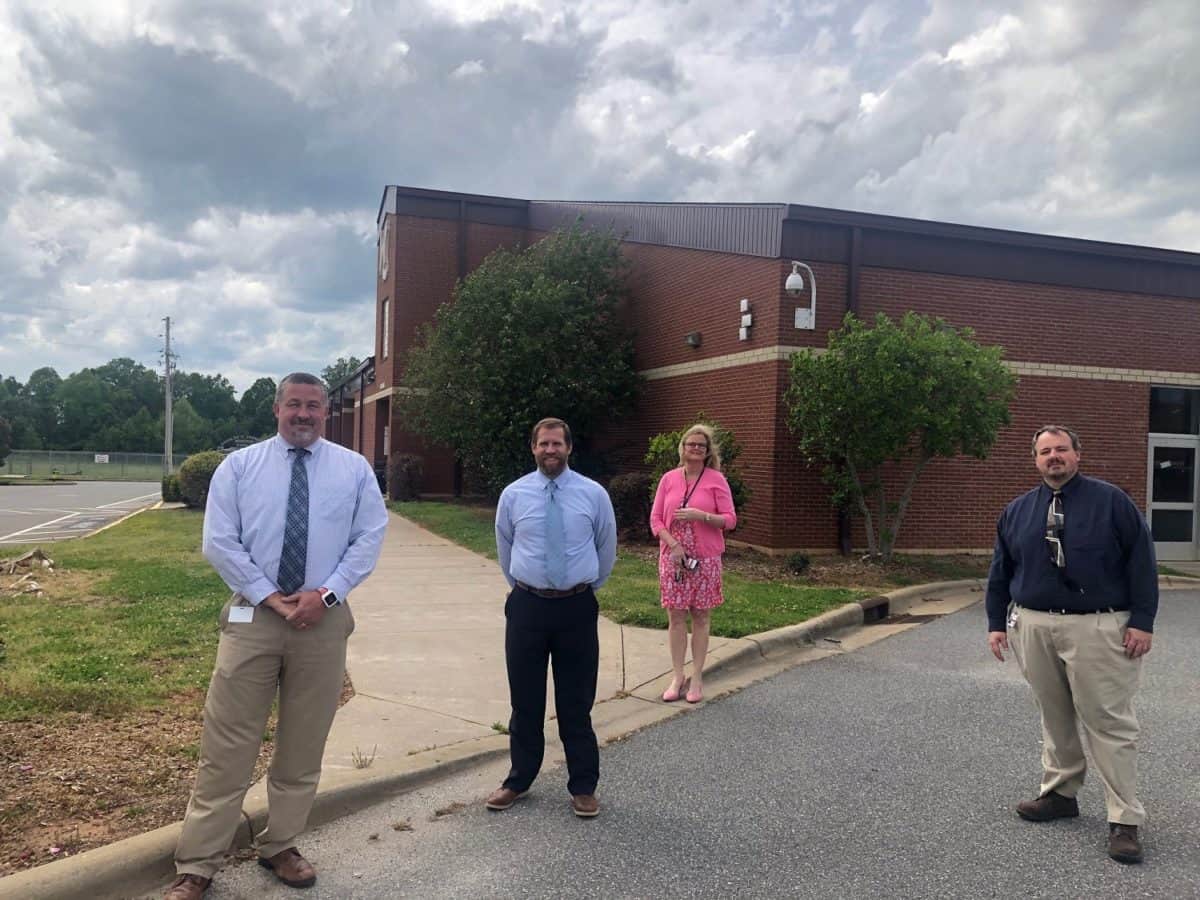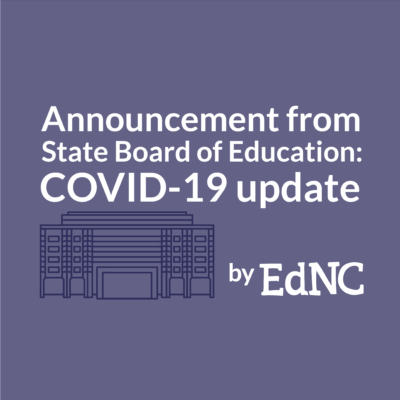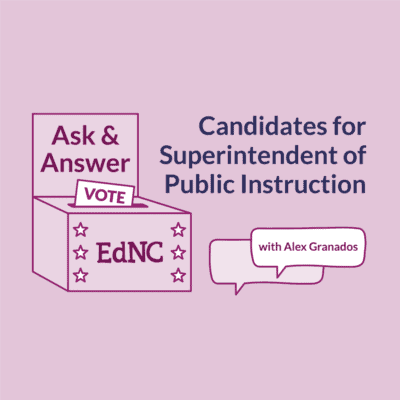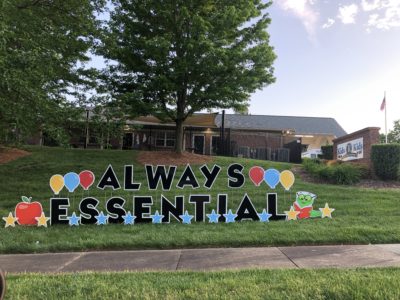
Update at 10:100 a.m. on June 30: A new superintendent of Asheville City Schools began on June 1.
Update at 12:30 p.m. on June 29: In an email, Jack Hoke added that a new superintendent of Nash-Rocky Mount City Schools began on March 1.
As schools are gearing up for perhaps the toughest year in recent history, some districts will be facing it with interim or new leadership.
Jack Hoke, executive director of the North Carolina School Superintendents’ Association, said he’s never seen anything like the turnover being seen now. And he thinks COVID-19 is, in part, to blame.
“We have turnover, but not this number all at the same time,” he said, adding later: “Ultimately, the superintendent is a very challenging job. It’s a high-demand, high-stress job, and then you add in the COVID-19 crisis … just a tremendous amount of challenges.”
Gov. Roy Cooper is set to make an announcement next week about what school will look like in the fall. There are three options ranging from having every student in the school with some precautions being taken, to having half full schools, and, finally, to full-on remote learning and empty school buildings.
Whatever Cooper decides, one thing is for sure: school in the fall will not look like it has in the past. And superintendents around the state are the ones that will have to figure out how to keep things rolling.
From January to October of this year, at least 16 school districts will see turnover in their top leadership. Superintendents around the state are leaving for jobs in other districts, retiring, or leaving for other reasons.
Here is a list of districts that are experiencing superintendent turnover.
- Ashe County Schools will have a new superintendent July 1st.
- Anson County Schools has a new superintendent as of June 10.
- Johnston County Schools will have a new superintendent as of July 1.
- Iredell County Schools will have a new superintendent as of July 1.
- Currituck County Schools: The superintendent left effective June 15.
- Carteret County Schools: The superintendent left at the end of last year.
- New Hanover County Schools: The superintendent left in February.
- Edenton-Chowan Public Schools: The superintendent is leaving effective July 1 to move to Carteret County Schools.
- Chapel Hill-Carrboro City Schools: The superintendent is leaving effective June 30.
- Wayne County Public Schools: The superintendent left effective June 11.
- Stanly County Schools: The superintendent is leaving effective July 1 and moving to Iredell County Schools.
- Sampson County Schools: The superintendent is leaving effective July 1 and moving to Johnston County Schools.
- Weldon City Schools: The superintendent retired back in January.
- Washington County Schools: The superintendent left effective May 1.
- Lincoln County Schools: The superintendent is retiring effective October 1.
- Scotland County Schools: The superintendent is retiring effective October 1.
Hoke admits that retirement and moving to positions in other counties is a driver of some turnover, but he thinks that COVID-19 is at least exacerbating the movement.
“I think it has, just because of the tremendous amount of pressure it’s created,” he said.
Patrick Miller, the superintendent of Greene County Schools, chair of the state’s Professional Educator Preparation and Standards Commission, and former State Superintendent of the Year, says he knows of at least one or two superintendents for whom COVID-19 hastened their decision to leave.
And Hoke said that this might not be the end. He doesn’t expect it to be at the level the state is seeing now, but he said he does expect the superintendent turnover to continue.
“This is my 45th year, and I have never seen anything like what the COVID-19 crisis has done for the stress level for superintendents,” Hoke said. “Not just superintendents, but principals, teachers, teacher assistants, bus drivers … it’s just created an enormous amount of stress for all educators.”
He added that hurricanes down east in recent years created extreme havoc as well, but for a statewide situation, this is the worst he’s ever seen.
The superintendent experience
Miller said he is pessimistic right now. He can’t sleep.
“I think about it when I wake up in the morning. I think about it when I lay down at night,” he said. “It doesn’t leave my mind.”
Faced with the task for figuring out how to open Greene County Schools in the fall, and without any definite knowledge of what plan the governor is going to choose, Miller said this has been the most stressful time in his career, and he feels inadequate.
Miller was 37 when he became a superintendent in 2008. He just turned 50.
“I definitely can feel those 13 years, but in the time since the closure, even my family has noticed the difference in my demeanor and in my stress level,” he said.
He said he just doesn’t know how to prepare for school in the fall. He doesn’t know what it’s going to look like. He doesn’t know what to budget for.
Plans being considered by the governor include the possibility of having buses run at half capacity and students being required to stay six feet apart. And guidance from the state Department of Health and Human Services (DHHS) is suggesting ample use of face coverings, hand sanitizers, regular wiping down of surfaces, etc.
Here are some of the things Miller is having to think about.
Let’s take transportation. Greene County has just under 2,900 students. If buses are required to run at half capacity, that could present a problem. The shortest route his buses take is an hour. The longest is over two hours. Limiting the number of students who can ride the bus would require tiered busing: multiple trips to get all the students. He estimates probably three.
That means if buses started at 6 a.m., the first group of students could possibly get to school at 8, the second at 10, and the next group at 12. Miller said there is no way the district could even stagger the start time of school to accommodate this reality. Also, Greene County’s buses usually only make one trip in the morning to get kids and bring them to school. This will triple their work. And there is no extra money for school transportation to help meet this possibility.
Miller also has to budget for face coverings for students, disinfectant, hand sanitizer, and other personal protective items if the governor’s plan requires it. At the moment, the only funding the state has allocated for personal protective equipment (PPE) for schools is $7 million in a bill that passed the legislature today.
That money is coming from federal COVID-19 funds sent to the state to be used by the General Assembly for pandemic-related issues. Rep. Donny Lambeth, R-Forsyth, said on the House floor today that this is just one step in helping public schools.
“There will be more money as we receive more money,” he said.
Miller said just for masks for teachers and students alone, it would cost $75,000 for his relatively small district. In a meeting recently, he was being told the numbers for disinfectant, hand sanitizer, and other items. When the cost figure got up to $600,000, he put an end to the discussion.
“I said stop, because we’re already bankrupt,” he said.
Rep. Ashton Clemmons, D-Guilford, debated the bill with the PPE funding today, and she said on the House floor that if schools reopen and actually follow DHHS guidelines, the cost for personal protective equipment for the state’s schools would be $38 million a month.
“In this bill, we allocate $7 million for 1.1 million students and 300,000 staff members,” she said.
The federal government did directly send North Carolina public schools more than $390 million in aid to deal with COVID-19. Miller said that a lot of people are pointing at that as a possible solution to districts’ budget woes. But Miller said districts had a lot of other needs that had to be met as well.
For example, Greene County provides electronic devices for all students in grades 6-12, but as a result of everything happening with COVID-19 and remote learning, the district decided to scale that program to begin in third grade so that every student from third grade and up had a device. They used some of the federal money for that. And then, since the students with personal devices increased, so too did the need for more teachers to have personal electronic devices. So more money went to that.
Miller said the district will likely be able to hold back some of the federal money to deal with the budget realities of reopening in the fall, but it won’t be much.
But even knowing how much money the district will need is a problem. Without knowing which plan the governor will choose, Miller said he has no way of knowing what his personnel needs are going to be. Right now, he said he is operating as though everything was normal.
“If something happens, we’ll just have to adjust,” he said. “I guess that’s thinking optimistically, but that’s sort of all I know how to do at this point.”
A bigger problem will come when the fall semester actually starts. Schools are allocated money by the state based on average daily membership. Basically, districts get money based on the number of students they have attending school at particular points in time. The districts get a budget based on what enrollment they’re projected to have, and then the state adjusts their budget after checking in early fall to see how many students they actually have.
The problem is that Miller said he is seeing estimates that 18% to 20% of students aren’t going to return even if schools are open. He said losing that much of the student body could mean a hit to his budget of about $5 million two months into the school year, which is roughly when the budget adjustment would be made.
Doing the figures off the top of his head, Miller tried to figure out how many teachers he would have to lay off to meet that shortfall. He figured that at a shortfall of $1 million, he would have to lay off 20 teachers. At $5 million, he would have to lose roughly 100.
“How disruptive is that to students and families during the school year if we have to combine and collapse classes?” he asked. “It’s just nightmare scenario after nightmare, and I don’t know how anybody can plan for them.”
He is hoping school districts can get a hold harmless from the state that would allow them to get money based on the number of students they were projected to have before COVID-19 hit. He said it would be more expensive for the state, but it would at least allow districts to stay in some sort of “stasis” until a vaccine is available.
These budget woes in Greene County and elsewhere are probably going to hit district fund balances hard. We reported previously that available fund balances at most North Carolina school districts are lower than they were in 2013, according to data from the Local Government Commission (LGC).
According to the LGC, available fund balance “is a savings account that schools can use” if unanticipated expenses or opportunities pop up. So basically, it’s tailor-made for this kind of emergency.
But with fund balances lower than they once were, districts have less of a cushion to soften the blow of what’s happening now.
“I don’t want to be run out of town at the end of the year next year because we ran into a budget deficit that I really had very little control over due to requirements that basically turned into unfunded mandates,” Miller said.
He anticipates that the first day of school this year is going to be considerably less joyful than it usually is.
“Normally on the first day of school people are happy and smiling and having a good time, and I’m not sure we’re going to see that this year,” Miller said.
How to handle the stress
Jim Merrill is currently the interim superintendent at Wayne County Schools. He has spent 17 years serving as a superintendent in three districts and two states, including at Wake County Public Schools, the largest school district in North Carolina.
Before he was called in recently to be interim superintendent in Wayne County, Merrill remembers thinking that it would be hard to level criticism at decisions made right now because there are no real comparisons.
“There is no playbook for what we’re into right now,” he said.
He said that what he tries to keep in mind as all this is happening is the health and safety of staff and students.
“Using that as a filter, it tends to lead you in a certain direction,” he said.
Merrill said he would like to see the governor start the state off in plan C, which is remote learning only. Then, if things improve, schools could transition to plan B — 50% capacity — and finally Plan A, which would have all children back in schools.
He said students are like “random molecules — they bounce around; they want to congregate.” It’s hard picturing school starting off safely with that being the case, he said.
Whatever the governor decides, districts have the option of taking a more restrictive route. So they could choose to go to full remote learning if they wanted to.
Merrill said that part of the problem with the plans and scenarios being laid out is that they don’t think things all the way through. For instance, he said, what if a student wants to get on a bus but has symptoms? Well, you can’t let them on the bus.
“OK, so now what?” he asked.
You can’t leave them on the side of the road. You have to find the parents. But where are the parents? Maybe they already went to work. How do you get in touch with them? How long do you sit there waiting for them to show up?
Or, what about if a child comes to school and then three days later the school finds out they have COVID-19? Do you then have to look at just who they were in a classroom with? Or do you look at the classroom and the cafeteria where they ate? Or do you have to screen the whole school?
“It could grow into a really big snowball that could cripple us,” he said.
As to whether Wayne County would choose remote learning regardless of what the governor says, Merrill said it’s similar to thinking about precipitation in the winter.
“It’s like a weather decision and it’s sort of snowing: you have to err on the side of caution and safety,” he said.
He said if they have to, the district will go to remote learning.
As superintendents consider what they are going to do, he said they should remember that they are uniquely positioned to handle the current situation. Figuring out transportation, feeding, training, purchasing, and warehousing — it’s kind of like being in the military, he said. It’s all about logistics. Ordering and stockpiling personal protective equipment, figuring out how to get kids in and out of school; those are all part of the skill set that superintendents have.
“We’re good at that,” he said. “The processes for all that is similar, it’s just that we’re going to different avenues now.”
As a senior superintendent in the state, Merrill has some advice on how to go about all this planning and implementation.
He said superintendents need to be flexible. And as they are making plans, they need to be open with the public about what those plans are and where in the planning process a district is. He said that nobody expects superintendents to have a complete answer on hand.
“It’s reasonable to also remind folks: guidance we get, rules we get, all of which we live by, are changing constantly,” he said.
Merrill also said that where possible and if there’s time, superintendents should use groups to make decisions. Bring together teachers, principals, parents, older students, community leaders, and even a member of the local board of education. That way, a superintendent can get buy-in from everybody involved.
Merrill said that at the end of the day he thinks that families and students are understanding. He said they know what superintendents are trying to do.
“We want the kids back. Everybody does,” he said. “But I think they also understand that we’re going to be cautious.”
For superintendents, he said be a little easier on yourself.
“Don’t let yourself think that you’re supposed to have the answers,” he said. “I mean, people look at us like that, and they’ll even be critical in a way, but in these times, that’s an impossible thing.”
And for everybody else, he said to remember that superintendents are just people, too.
“We’re citizens also. We’re taxpayers. We’re worried about our parents. We’re worried about our young kids. We’re all equal when it comes to that stuff. And that’s a good reminder for folks,” he said.
Editor’s Note: Patrick Miller serves on EdNC’s board of directors




